Life-Cycle Carbon Emissions and Energy Return on Investment for 80% Domestic Renewable Electricity with Battery Storage in California (U.S.A.)
Abstract
1. Introduction
2. Materials
2.1. Power Dispatch Data for California
2.1.1. Electricity Generation Data per Technology (Hourly Resolution)
2.1.2. Electricity Imports Data (Hourly Resolution)
2.1.3. Electricity Demand Data (Hourly Resolution)
2.1.4. Power Curtailment Data for Wind and Solar Generation (Hourly Resolution)
2.2. Current and Future Electricity Generation and Storage Technologies in California
2.2.1. Nuclear
2.2.2. Gas-Fired Electricity
2.2.3. Geothermal
2.2.4. Biomass
2.2.5. Biogas
2.2.6. Hydro
2.2.7. Wind
2.2.8. Concentrating Solar Power (CSP)
2.2.9. Photovoltaic (PV) Solar
2.2.10. Energy Storage
2.3. California Grid Mix Composition in 2018
3. Methods
3.1. Definition of the Future Grid Mix Scenario in 2030
- (1)
- It is assumed that in 2030 the total hourly electricity demand profile will remain the same as in 2018. This future extrapolation is based on the analysis of the demand profiles from 2001 to 2019, which shows that the cumulative yearly electricity demand remained nearly constant during the past 19 years, with minimal oscillations around a centre value of approximately 200 TWh/year. This result appears to be “due to a combination of energy efficiency measures and less electricity-intensive industry that counterbalances increased population and economy” [62]. Other potential variations in electricity demand (both its hourly profile and total year-end cumulative value), for instance due to a possible large-scale deployment of electric vehicles (EVs) and the associated requirement for battery charging, are outside the scope of this study.
- (2)
- CAISO will rely single-handedly on solar PV as the technology of choice to increase the penetration of renewable energy in the grid. This is a bold assumption, but it was deemed reasonable in view of the abundance of solar irradiation in California, and it also appears to be supported by a simple linear extrapolation of recent past trends, which indicate that wind installations in California have plateaued, whereas PV installations have been sharply and consistently rising (see Figure 3). The final value of installed PV power in 2030 was determined iteratively, so as to match a target of 80% total net domestic renewable electricity generation, after duly taking into account all PV storage and curtailment losses (as explained below). Hence, the PV installed capacity in 2030 is 43,710 MW, as shown in Figure 3. The hourly “potential” (i.e., pre-curtailment and pre-storage) PV output profile was calculated by scaling up the corresponding 2018 “potential” PV electricity generation, proportionally to the respective 2030 vs. 2018 installed power levels.
- (3)
- Lithium-ion batteries (LIBs) will be deployed as the storage technology of choice (as discussed in Section 2.2.10). The amount of assumed installed LIB power (P) and the maximum consecutive hours of storage duration at such maximum power (t) were set after performing a parametric investigation of the resulting % of VRE curtailment ensuing from a range of P and t values (following the grid balancing algorithm described at points 7 and 8 below). The results of this parametric analysis are illustrated in Figure 4; in order to make a realistically conservative assumption on the amount of storage, for the purposes of this study the choice was therefore made to set P = 60% of the installed PV power (a value consistent with previous literature [63,64]) and t = 6 h. When taken together, such values of P and t lead to the total installed storage capacity E = P × t. As reported in Table 1, this resulted in 2.8% of the overall “potential” VRE generation being curtailed.
- (4)
- Nuclear generation will be zero, consistently with the planned decommissioning of all remaining reactors in California (as explained in Section 2.2.1).
- (5)
- “Other renewables” (i.e., hydro, biogas, biomass and geothermal), wind and CSP generation profiles will remain exactly the same as in 2018.
- (6)
- Single-cycle gas turbines (SCGT) will be completely phased out.
- (7)
- Combined cycle gas turbine (NGCC) output and electricity imports will be used, together with LIB energy storage, to balance overall supply and demand, following a strict order of merit, as follows:
- (a)
- On an hourly basis, the increased PV output in 2030 with respect to 2018 (more precisely: the difference between the “potential” PV output in 2030, calculated as per point 2 above, and the net PV output in 2018) will first be compensated for by reducing NGCC output. This is deemed the preferred strategy since gas-fired electricity is the most carbon-intensive technology in the California grid mix, and it is also more carbon-intensive than the average mix of technologies used to generate the electricity imported by California [65].
- (b)
- Then, if/when no residual NGCC power is left, the second intervention will be to curb imported electricity.
- (c)
- Then, if/when the hourly imported electricity value has been reduced to zero too, and the “potential” PV output is actually in excess of the total demand profile value, such excess PV output will be preferentially routed into storage, as long as neither total storage capacity (E) nor maximum storage power (P) are exceeded.
- (d)
- Finally, if, after taking steps (a–c) above, either the maximum E or maximum P condition is met, then the residual excess PV output (i.e., the share thereof that cannot be sent to storage) is curtailed.
- (8)
- After each PV “peak”, i.e., as soon as the “potential” PV profile curve has returned below the total demand profile curve, the electricity stored in LIBs will start being dispatched back to the grid (at a maximum rate limited by P), and will thus curb NGCC output (in the first instance) and imported electricity (if/after NGCC output has already been reduced to zero) with respect to their respective 2018 hourly values.
3.2. Life Cycle Assessment (LCA)
3.3. Net Energy Analysis (NEA)
4. Results and Discussion
5. Conclusions
Supplementary Materials
Author Contributions
Funding
Conflicts of Interest
References
- Ritchie, H.; Roser, M. CO2 and Greenhouse Gas Emissions. Our World in Data. Available online: https://ourworldindata.org/co2-and-other-greenhouse-gas-emissions#global-warming-to-date (accessed on 19 June 2020).
- Dejuán, Ó.; Lenzen, M.; Cadarso, M.Á. (Eds.) Environmental and Economic Impacts of Decarbonization: Input-Output Studies on the Consequences of the 2015 Paris Agreements, 1st ed.; Routledge: Abingdon, UK, 2018; p. 402. [Google Scholar]
- Sørensen, B. Energy and resources. Science 1975, 189, 255–260. [Google Scholar] [CrossRef] [PubMed]
- Lovins, A.B. Energy strategy: The road not taken. Foreign Aff. 1976, 55, 636–640. [Google Scholar] [CrossRef]
- Sørensen, B.; Meibom, P. A global renewable energy scenario. Int. J. Glob. Energy Issues 2000, 13, 196–276. [Google Scholar] [CrossRef]
- Fthenakis, V.; Mason, J.E.; Zweibel, K. The technical, geographical, and economic feasibility for solar energy to supply the energy needs of the US. Energy Policy 2009, 37, 387–399. [Google Scholar] [CrossRef]
- Jacobson, M.Z.; Delucchi, M.A.; Cameron, M.A.; Mathiesen, B.V. Matching demand with supply at low cost in 139 countries among 20 world regions with 100% intermittent wind, water, and sunlight (WWS) for all purposes. Renew. Energy 2018, 123, 236–248. [Google Scholar] [CrossRef]
- Brown, T.W.; Bischof-Niemz, T.; Blok, K.; Breyer, C.; Lund, H.; Mathiesen, B.V. Response to ‘Burden of proof: A comprehensive review of the feasibility of 100% renewable-electricity systems’. Renew. Sust. Energy Rev. 2018, 92, 834–847. [Google Scholar] [CrossRef]
- Diesendorf, M.; Elliston, B. The feasibility of 100% renewable electricity systems: A response to critics. Renew. Sust. Energy Rev. 2018, 93, 318–330. [Google Scholar] [CrossRef]
- Raugei, M.; Leccisi, E. A comprehensive assessment of the energy performance of the full range of electricity generation technologies deployed in the United Kingdom. Energy Policy 2016, 90, 46–59. [Google Scholar] [CrossRef]
- Jones, C.; Gilbert, P.; Raugei, M.; Leccisi, E.; Mander, S. An Approach to Prospective Consequential LCA and Net Energy Analysis of Distributed Electricity Generation. Energy Policy 2017, 100, 350–358. [Google Scholar] [CrossRef]
- Raugei, M.; Leccisi, E.; Azzopardi, B.; Jones, C.; Gilbert, P.; Zhang, L.; Zhou, Y.; Mander, S.; Mancarella, P. A multi-disciplinary analysis of UK grid mix scenarios with large-scale PV deployment. Energy Policy 2018, 114, 51–62. [Google Scholar] [CrossRef]
- Raugei, M.; Leccisi, E.; Fthenakis, V.; Moragas, R.E.; Simsek, Y. Net energy analysis and life cycle energy assessment of electricity supply in Chile: Present status and future scenarios. Energy 2018, 162, 659–668. [Google Scholar] [CrossRef]
- Leccisi, E.; Raugei, M.; Fthenakis, V. The energy performance of potential scenarios with large-scale PV deployment in Chile a dynamic analysis 2018. In Proceedings of the IEEE 7th World Conference on Photovoltaic Energy Conversion (WCPEC), Waikoloa Village, HI, USA, 10–15 June 2018; pp. 2441–2446. [Google Scholar]
- Murphy, D.J.; Raugei, M. The Energy Transition in New York: A Greenhouse Gas, Net Energy and Life-Cycle Energy Analysis. Energy Technol. 2020. [Google Scholar] [CrossRef]
- Osorio-Aravena, J.C.; Aghahosseini, A.; Bogdanov, D.; Caldera, U.; Muñoz-Cerón, E.; Breyer, C. Transition toward a fully renewable based energy system in Chile by 2050 across power, heat, transport and desalination sectors. Int. J. Sustain. Energy Plan. Manag. 2020, 25, 77–94. [Google Scholar]
- Raugei, M.; Kamran, M.; Hutchinson, M. A Prospective Net Energy and Environmental Life-Cycle Assessment of the UK Electricity Grid. Energies 2020, 13, 2207. [Google Scholar] [CrossRef]
- California State. Senate Bill No. 100 Chapter 312. An Act to amend Sections 399.11, 399.15, and 399.30 of, and to Add Section 454.53 to, the Public Utilities Code, Relating to Energy. 2018. Available online: https://leginfo.legislature.ca.gov/faces/billTextClient.xhtml?bill_id=201720180SB100 (accessed on 19 June 2020).
- Haegel, N.M.; Atwater, H.; Barnes, T.; Breyer, C.; Burrell, A.; Chiang, Y.M.; De Wolf, S.; Dimmler, B.; Feldman, D.; Glunz, S.; et al. Terawatt-scale photovoltaics: Transform global energy. Science 2019, 364, 836–838. [Google Scholar] [CrossRef] [PubMed]
- Arbabzadeh, M.; Sioshansi, R.; Johnson, J.X.; Keoleian, G.A. The role of energy storage in deep decarbonization of electricity production. Nat. Commun. 2019, 10, 1–11. [Google Scholar] [CrossRef]
- Comello, S.; Reichelstein, S. The emergence of cost effective battery storage. Nat. Commun. 2019, 10, 1–9. [Google Scholar] [CrossRef]
- Cebulla, F.; Haas, J.; Eichman, J.; Nowak, W.; Mancarella, P. How much electrical energy storage do we need? A synthesis for the US, Europe, and Germany. J. Clean. Prod. 2018, 181, 449–459. [Google Scholar] [CrossRef]
- Denholm, P.; Margolis, R. Energy Storage Requirements for Achieving 50% Solar Photovoltaic Energy Penetration in California. National Renewable Energy Laboratory 2016. NREL/TP-6A20-66595. Available online: https://www.nrel.gov/docs/fy16osti/66595.pdf (accessed on 19 June 2020).
- California ISO. Renewable Grid Initiative. Energy Storage. Perspectives from California and Europe 2019. Available online: http://www.caiso.com/Documents/EnergyStorage-PerspectivesFromCalifornia-Europe.pdf (accessed on 19 June 2020).
- Wadia, C.; Albertus, P.; Srinivasan, V. Resource constraints on the battery energy storage potential for grid and transportation applications. J. Power Sources 2011, 196, 1593–1598. [Google Scholar] [CrossRef]
- Roy, S.; Sinha, P.; Shah, S.I. Assessing the Techno-Economics and Environmental Attributes of Utility-Scale PV with Battery Energy Storage Systems (PVS) Compared to Conventional Gas Peakers for Providing Firm Capacity in California. Energies 2020, 13, 488. [Google Scholar] [CrossRef]
- Pellow, M.A.; Ambrose, H.; Mulvaney, D.; Betita, R.; Shaw, S. Research gaps in environmental life cycle assessments of lithium ion batteries for grid-scale stationary energy storage systems: End-of-life options and other issues. SMT 2020, 23, 00120. [Google Scholar] [CrossRef]
- Raugei, M.; Leccisi, E.; Fthenakis, V.M. What Are the Energy and Environmental Impacts of Adding Battery Storage to Photovoltaics? A Generalized Life Cycle Assessment. Energy Technol. 2020. [Google Scholar] [CrossRef]
- Diesendorf, M.; Wiedmann, T. Implications of trends in energy return on energy invested (EROI) for transitioning to renewable electricity. Ecol. Econ. 2020, 176, 106726. [Google Scholar] [CrossRef]
- California ISO 2013. Demand Response and Energy Efficiency Roadmap: Maximizing Preferred Resources. Available online: https://www.caiso.com/Documents/DR-EERoadmap.pdf (accessed on 19 June 2020).
- California ISO. Available online: http://www.caiso.com/about/Pages/default.aspx (accessed on 19 June 2020).
- Congress. Gov. Available online: https://www.congress.gov/bill/102nd-congress/house-bill/776?q=%7B%22search%22%3A%5B%22H.R.776.ENR%22%5D%7D&s=8&r=7 (accessed on 19 June 2020).
- Federal Energy Regulatory Commission. Available online: https://www.ferc.gov/legal/maj-ord-reg/land-docs/order888.asp (accessed on 19 June 2020).
- Federal Energy Regulatory Commission. Available online: https://www.ferc.gov/legal/maj-ord-reg/land-docs/order889.asp (accessed on 19 June 2020).
- California ISO. Available online: https://www.caiso.com/TodaysOutlook/Pages/default.aspx (accessed on 19 June 2020).
- California Energy Commission. Electric Generation Capacity and Energy. Available online: https://www.energy.ca.gov/data-reports/energy-almanac/california-electricity-data/electric-generation-capacity-and-energy (accessed on 15 July 2020).
- California Energy Commission. Available online: https://www.energy.ca.gov/data-reports/california-power-generation-and-power-sources/nuclear-energy (accessed on 19 June 2020).
- Ecoinvent Life Cycle Inventory Database. 2019. Available online: https://www.ecoinvent.org/database/database.html (accessed on 19 June 2020).
- Pacific Gas and Electric Company. Available online: https://www.pge.com/en_US/safety/how-the-system-works/diablo-canyon-power-plant/diablo-canyon-power-plant.page (accessed on 19 June 2020).
- Nyberg, M. Thermal Efficiency of Gas-Fired Generation in California: 2016 Update. California Energy Commission. CEC 200-2017-003; 2017. Available online: https://ww2.energy.ca.gov/2017publications/CEC-200-2017-003/CEC-200-2017-003.pdf (accessed on 19 June 2020).
- Southern California Gas Company. Available online: https://www.socalgas.com/regulatory/cgr (accessed on 19 June 2020).
- California Energy Commission. Available online: https://ww2.energy.ca.gov/almanac/renewables_data/biomass/index_cms.php (accessed on 19 June 2020).
- California Energy Commission. Available online: https://ww2.energy.ca.gov/biomass/anaerobic.html (accessed on 19 June 2020).
- US Geological Survey. Available online: https://emp.lbl.gov/publications/us-wind-turbine-database-files (accessed on 19 June 2020).
- National Renewable Energy Laboratory (NREL). Available online: https://solarpaces.nrel.gov/by-country/US (accessed on 19 June 2020).
- Moreno-Ruiz, E.; Valsasina, L.; FitzGerald, D.; Brunner, F.; Symeonidis, A.; Bourgault, G.; Wernet, G. Documentation of Changes Implemented in Ecoinvent Database v3.6; Ecoinvent Association: Zürich, Switzerland, 2019. [Google Scholar]
- Burkhardt, J.; Heath, G.; Turchi, C. Life cycle assessment of a parabolic trough concentrating solar power plant and the impacts of key design alternatives. Environ. Sci. Technol. 2011, 45, 2457–2464. [Google Scholar] [CrossRef] [PubMed]
- Whitaker, M.B.; Heath, G.A.; Burkhardt, J.J., III; Turchi, C.S. Life cycle assessment of a power tower concentrating solar plant and the impacts of key design alternatives. Environ. Sci. Technol. 2013, 47, 5896–5903. [Google Scholar] [CrossRef]
- Photovoltaics Report. Fraunhofer Institute for Solar Energy Systems. 2019. Available online: https://www.ise.fraunhofer.de/en/publications/studies/photovoltaics-report.html (accessed on 20 March 2020).
- Leccisi, E.; Raugei, M.; Fthenakis, V. The energy and environmental performance of ground-mounted photovoltaic systems—A timely update. Energies 2016, 9, 622. [Google Scholar] [CrossRef]
- Frischknecht, R.; Itten, R.; Sinha, P.; De Wild-Scholten, M.; Zhang, J.; Fthenakis, V.; Kim, H.C.; Raugei, M.; Stucki, M. Life Cycle Inventories and Life Cycle Assessment of Photovoltaic Systems; Report IEA-PVPS T12-04:2015; International Energy Agency (IEA): Paris, France, 2015. [Google Scholar]
- Corcelli, F.; Ripa, M.; Leccisi, E.; Cigolotti, V.; Fiandra, V.; Graditi, G.; Sannino, L.; Tammaro, M.; Ulgiati, S. Sustainable urban electricity supply chain—Indicators of material recovery and energy savings from crystalline silicon photovoltaic panels end-of-life. Ecol. Indic. 2016, 94, 37–51. [Google Scholar] [CrossRef]
- Frischknecht, R.; Itten, R.; Wyss, F.; Blanc, I.; Heath, G.; Raugei, M.; Sinha, P.; Wade, A. Life Cycle Assessment of Future Photovoltaic Electricity Production from Residential-Scale Systems Operated in Europe; Report T12-05:2015; International Energy Agency: Paris, France, 2015; Available online: http://www.iea-pvps.org (accessed on 19 June 2020).
- Leccisi, E.; Fthenakis, V. Life-cycle environmental impacts of single-junction and tandem perovskite PVs: A critical review and future perspectives. Prog. Energy 2020, in press. [Google Scholar] [CrossRef]
- Palizban, O.; Kauhaniemi, K. Energy storage systems in modern grids—Matrix of technologies and applications. J. Energy Storage 2016, 6, 248–259. [Google Scholar] [CrossRef]
- IRENA. Electricity Storage and Renewables: Costs and Markets to 2030; International Renewable Energy Agency: Abu Dhabi, UAE, 2017. Available online: https://www.irena.org/publications/2017/Oct/Electricity-storage-and-renewables-costs-and-markets (accessed on 19 June 2020).
- Lindley, D. Smart grids: The energy storage problem. Nature 2010, 463, 18–20. [Google Scholar] [CrossRef]
- Blakers, A.; Lu, B.; Stocks, M. 100% renewable electricity in Australia. Energy 2017, 133, 471–482. [Google Scholar] [CrossRef]
- Center for Sustainable Systems. U.S. Energy Storage Factsheet; Pub. No. CSS15-17. University of Michigan: Ann Arbor, MI, USA, 2018. Available online: http://css.umich.edu/factsheets/us-grid-energy-storage-factsheet (accessed on 19 June 2020).
- Xu, B.; Oudalov, A.; Ulbig, A.; Andersson, G.; Kirschen, D.S. Transactions on Smart Grid. IEEE 2016, 9, 1131–1140. [Google Scholar]
- Wong, L. A Review of Transmission Losses in Planning Studies: Staff Paper; California Energy Commission: Sacramento, CA, USA, 2011. [Google Scholar]
- Colbertaldo, P.; Agustin, S.B.; Campanari, S.; Brouwer, J. Impact of hydrogen energy storage on California electric power system: Towards 100% renewable electricity. Int. J. Hydrogen Energy 2019, 44, 9558–9576. [Google Scholar] [CrossRef]
- Fu, R.; Remo, T.; Margolis, R. 2018 U.S. Utility-Scale Photovoltaics-Plus-Energy Storage System Costs Benchmark; Report NREL/TP-6A20-71714; National Renewable Energy Laboratory: Golden, CO, USA, 2018. Available online: https://www.nrel.gov/docs/fy19osti/71714.pdf (accessed on 19 June 2020).
- Denholm, P.; Eichman, J.; Margolis, R. Evaluating the Technical and Economic Performance of PV Plus Storage Power Plants; Report NREL/TP-6A20-68737; National Renewable Energy Laboratory: Golden, CO, USA, 2017. Available online: https://www.nrel.gov/docs/fy17osti/68737.pdf (accessed on 19 June 2020).
- California Energy Commission. 2018 Total System Electric Generation. Available online: https://www.energy.ca.gov/data-reports/energy-almanac/california-electricity-data/2018-total-system-electric-generation (accessed on 19 June 2020).
- Environmental Management. Life Cycle Assessment. Principles and Framework. Standard ISO 14040; International Organization for Standardization: Geneva, Switzerland, 2006; Available online: https://www.iso.org/standard/37456.html (accessed on 27 March 2020).
- Environmental Management. Life Cycle Assessment. Principles and Framework. Standard ISO 14044; International Organization for Standardization: Geneva, Switzerland, 2006; Available online: https://www.iso.org/standard/38498.html (accessed on 27 March 2020).
- Frischknecht, R.; Wyss, F.; Büsser Knöpfel, S.; Lützkendorf, T.; Balouktsi, M. Cumulative energy demand in LCA: The energy harvested approach. Int. J. Life Cycle ASS 2015, 20, 957–969. [Google Scholar] [CrossRef]
- Carbajales-Dale, M.; Barnhart, C.; Brandt, A.; Benson, S. A better currency for investing in a sustainable future. Nat. Clim. Chang. 2014, 4, 524–527. [Google Scholar] [CrossRef]
- Hall, C.; Lavine, M.; Sloane, J. Efficiency of Energy Delivery Systems: I. an Economic and Energy Analysis. Environ. Manag. 1979, 3, 493–504. [Google Scholar] [CrossRef]
- Murphy, D.J.; Carbajales-Dale, M.; Moeller, D. Comparing Apples to Apples: Why the Net Energy Analysis Community Needs to Adopt the Life-Cycle Analysis Framework. Energies 2016, 9, 917. [Google Scholar] [CrossRef]
- Raugei, M. Net Energy Analysis must not compare apples and oranges. Nat. Energy 2019, 4, 86–88. [Google Scholar] [CrossRef]
- Classen, M.; Althaus, H.-J.; Blaser, S.; Doka, G.; Jungbluth, N.; Tuchschmid, M. Life Cycle Inventories of Metals; Final report ecoinvent data v2.1 No.10; Swiss Centre for Life Cycle Inventories: Dübendorf, CH, USA, 2009. [Google Scholar]
- Guinée, J.B.; Gorrée, M.; Heijungs, R.; Huppes, G.; Kleijn, R.; de Koning, A.; van Oers, L.; Wegener Sleeswijk, A.; Suh, S.; Udo de Haes, H.A.; et al. Handbook on Life Cycle Assessment. Operational Guide to the ISO Standards; Kluwer Academic Publishers: Dordrecht, NL, USA, 2002; p. 692. ISBN 1-4020-0228-9. [Google Scholar]
- Schulze, R.; Guinée, J.; van Oersa, L.; Alvarenga, R.; Dewulf, J.; Drielsma, J. Abiotic resource use in life cycle impact assessment—Part I—Towards a common perspective. Resour. Conserv. Recycl. 2020, 154. [Google Scholar] [CrossRef]
- Schulze, R.; Guinée, J.; van Oersa, L.; Alvarenga, R.; Dewulf, J.; Drielsma, J. Abiotic resource use in life cycle impact assessment—Part II—Linking perspectives and modelling concepts. Resour. Conserv. Recycl. 2020, 154. [Google Scholar] [CrossRef]
- Van Oers, L.; Guinée, J.; Heijungs, R. Abiotic resource depletion potentials (ADPs) for elements revisited—Updating ultimate reserve estimates and introducing time series for production data. Int. J. Life Cycle Ass. 2020, 25, 294–308. [Google Scholar] [CrossRef]
- Nuss, P.; Eckelman, M.J. Life cycle assessment of metals: A scientific synthesis. PLoS ONE 2014, 9, 101298. [Google Scholar] [CrossRef] [PubMed]
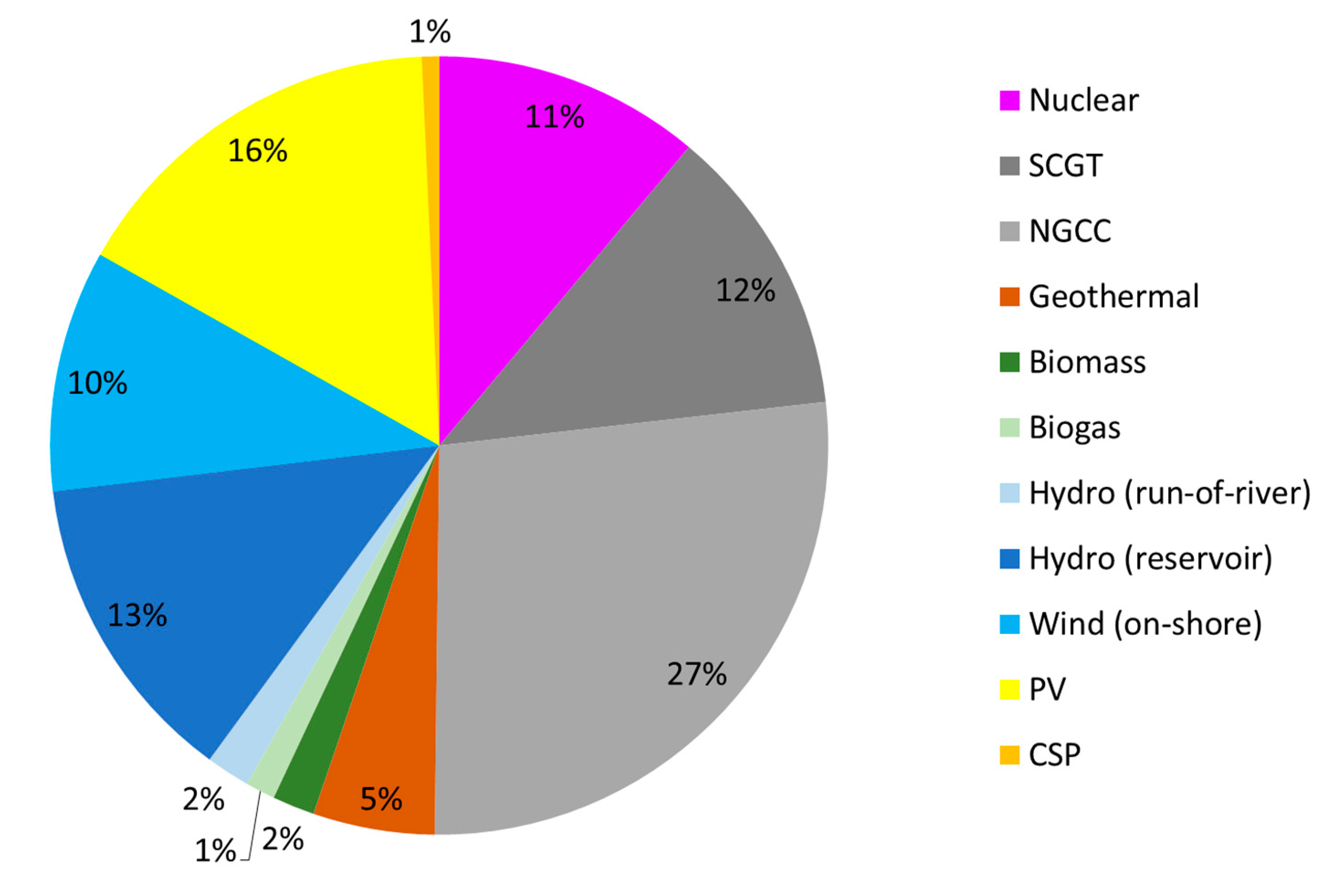
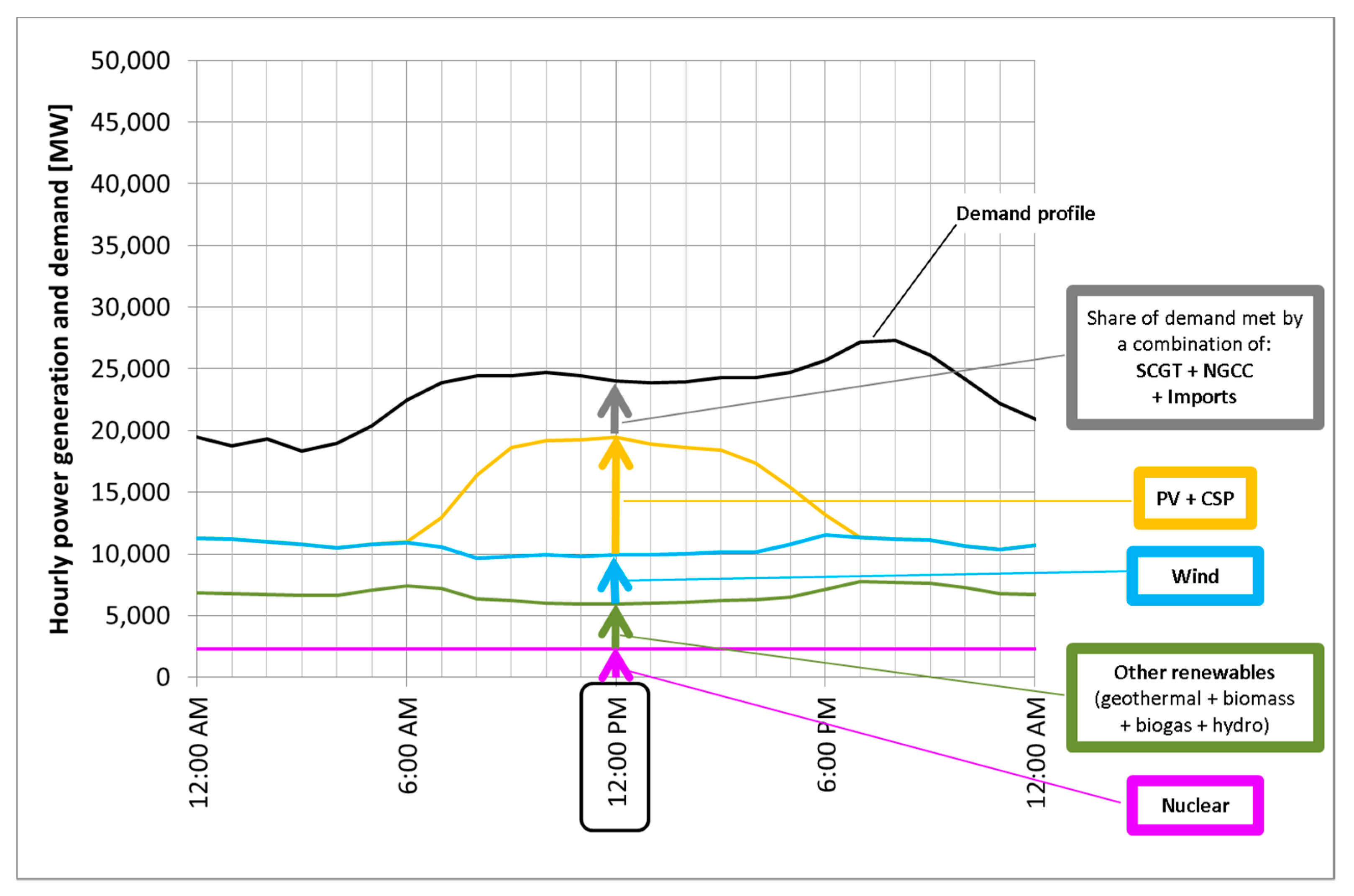
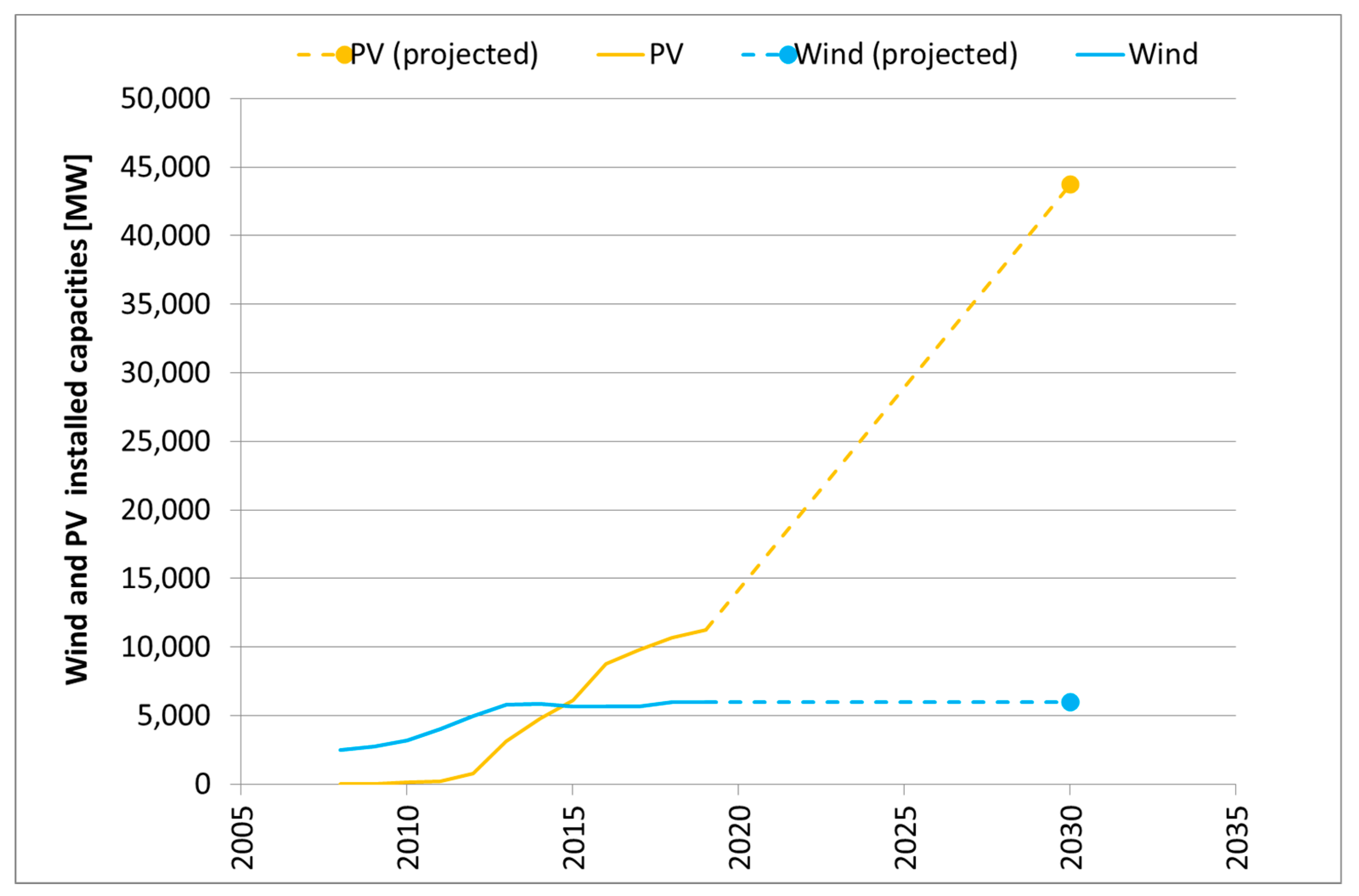
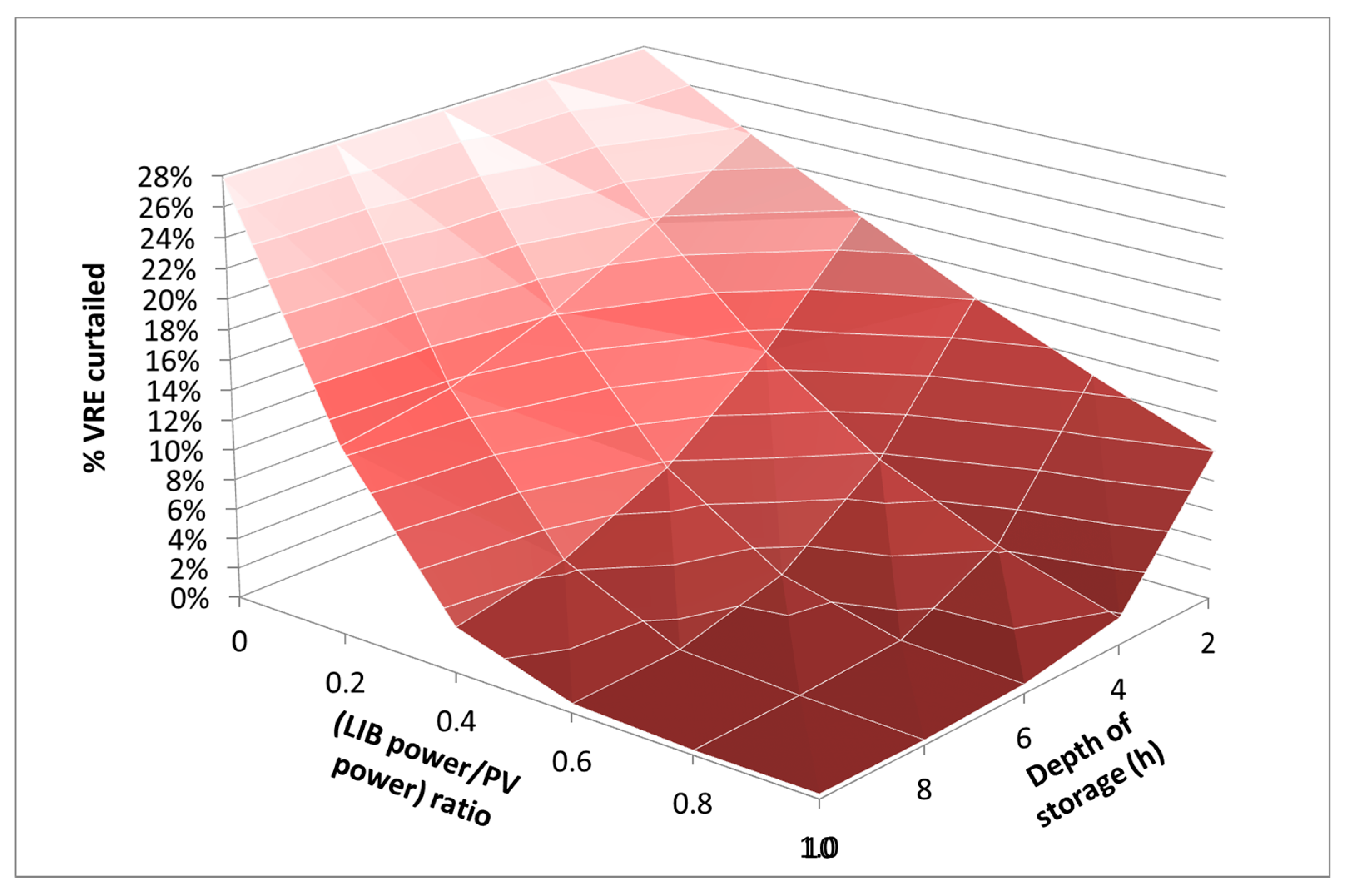
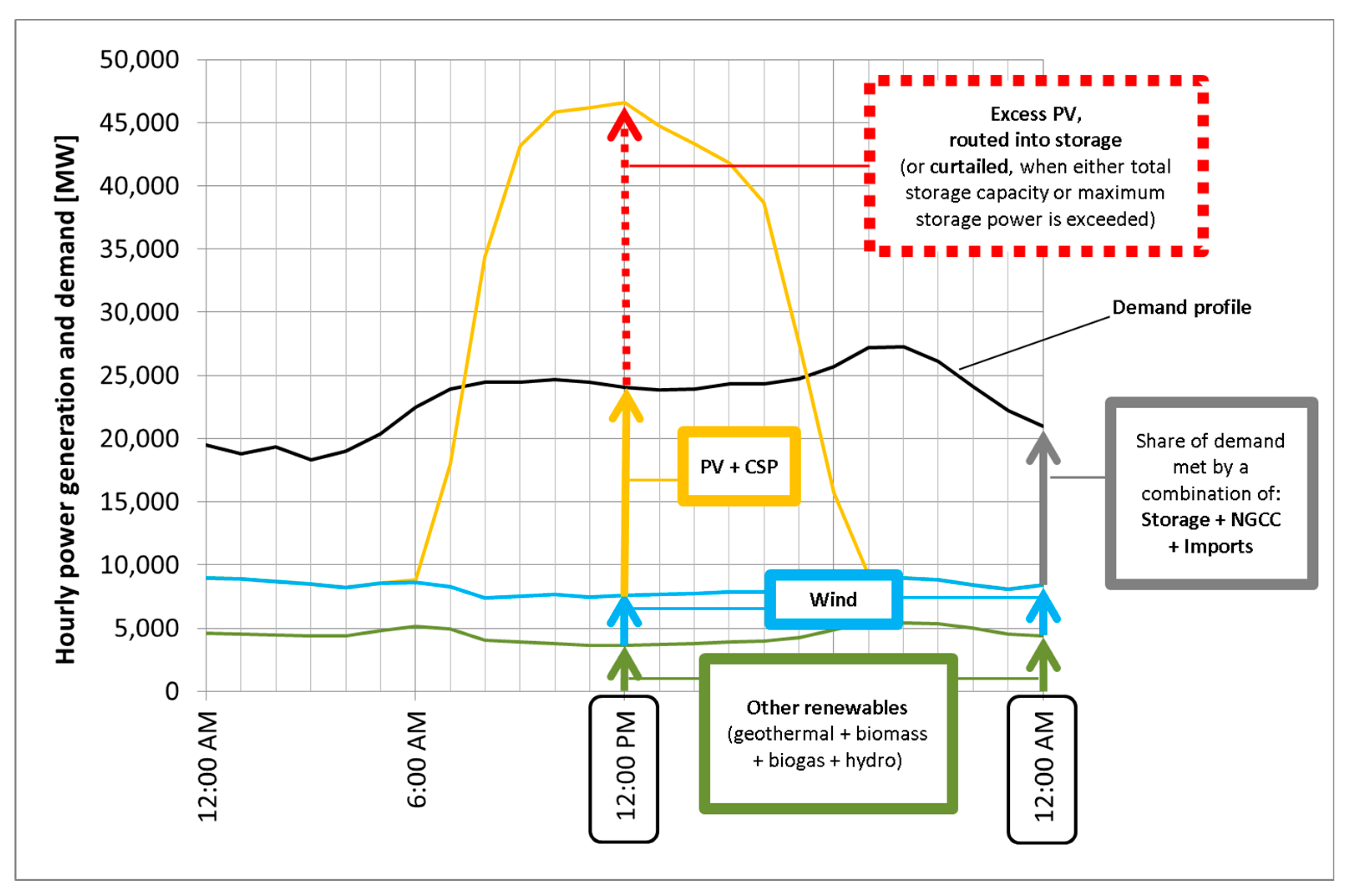
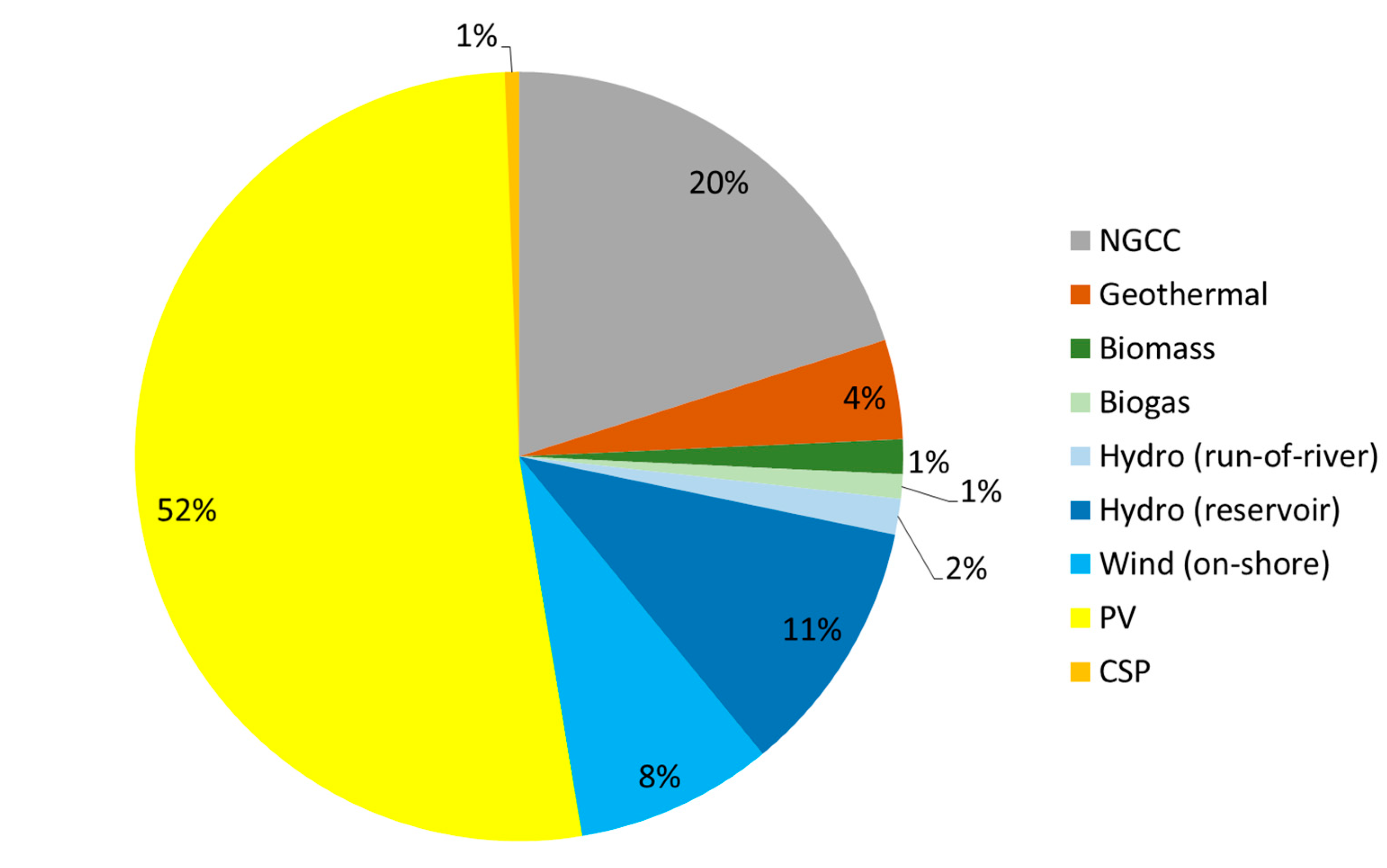
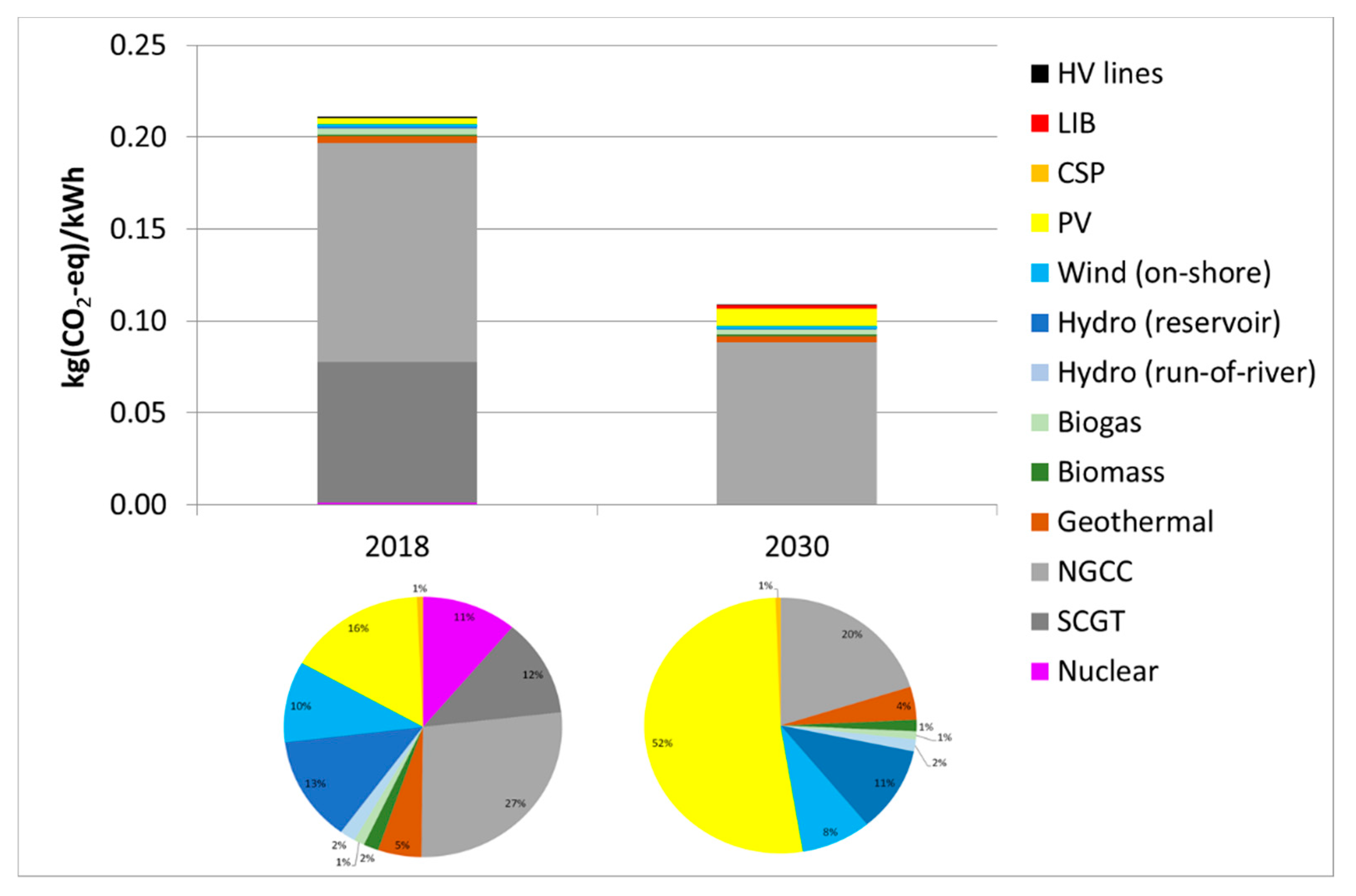
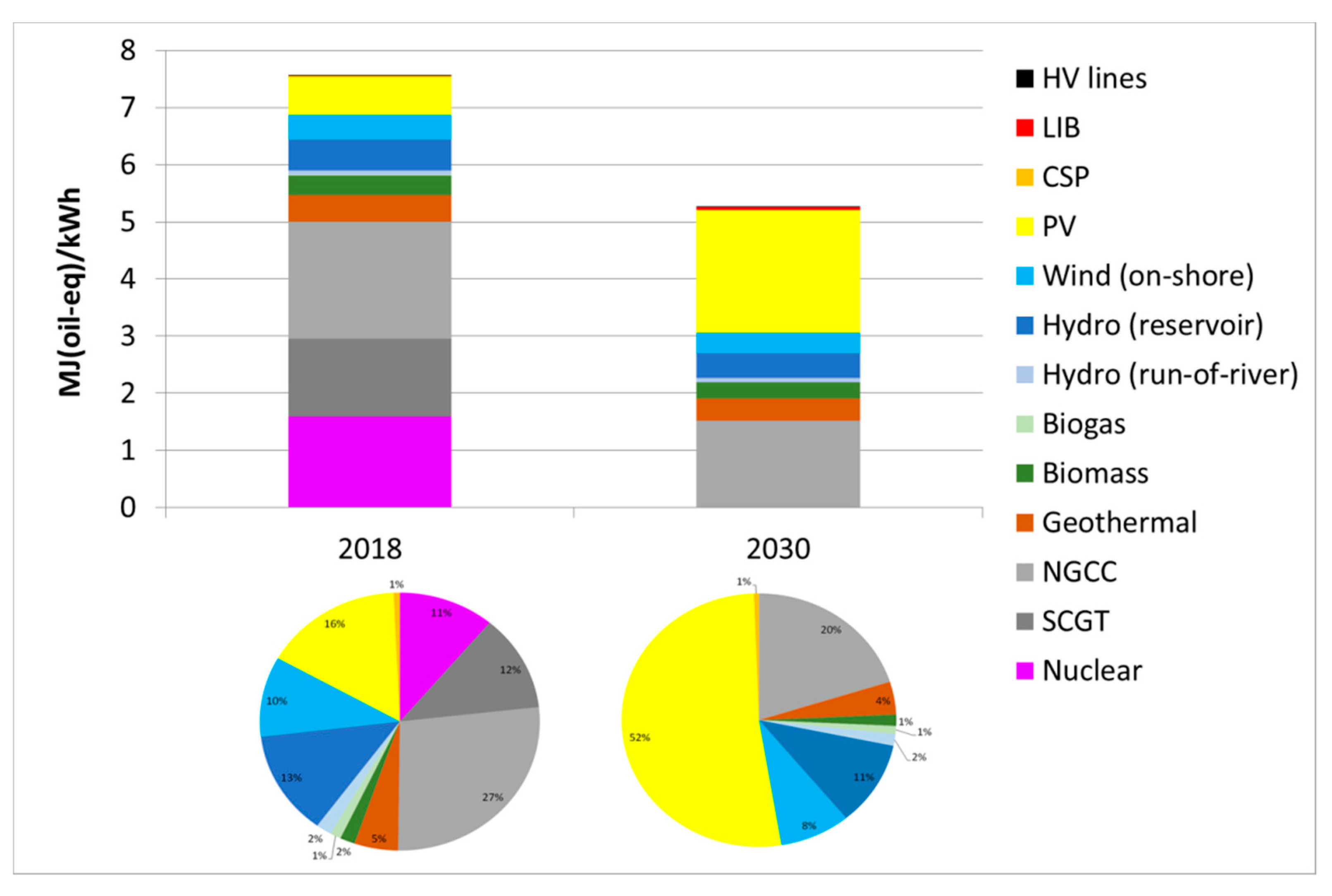
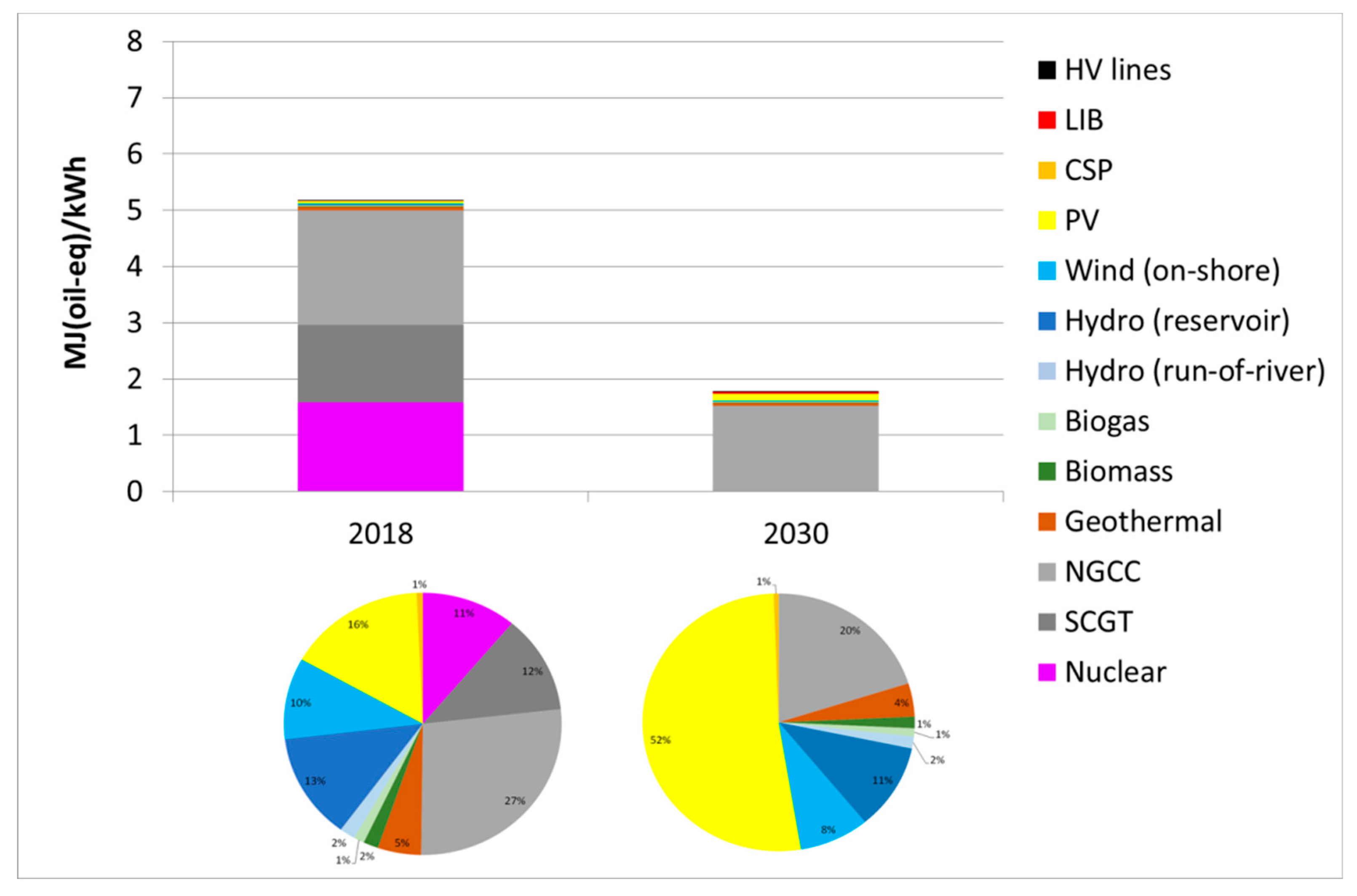
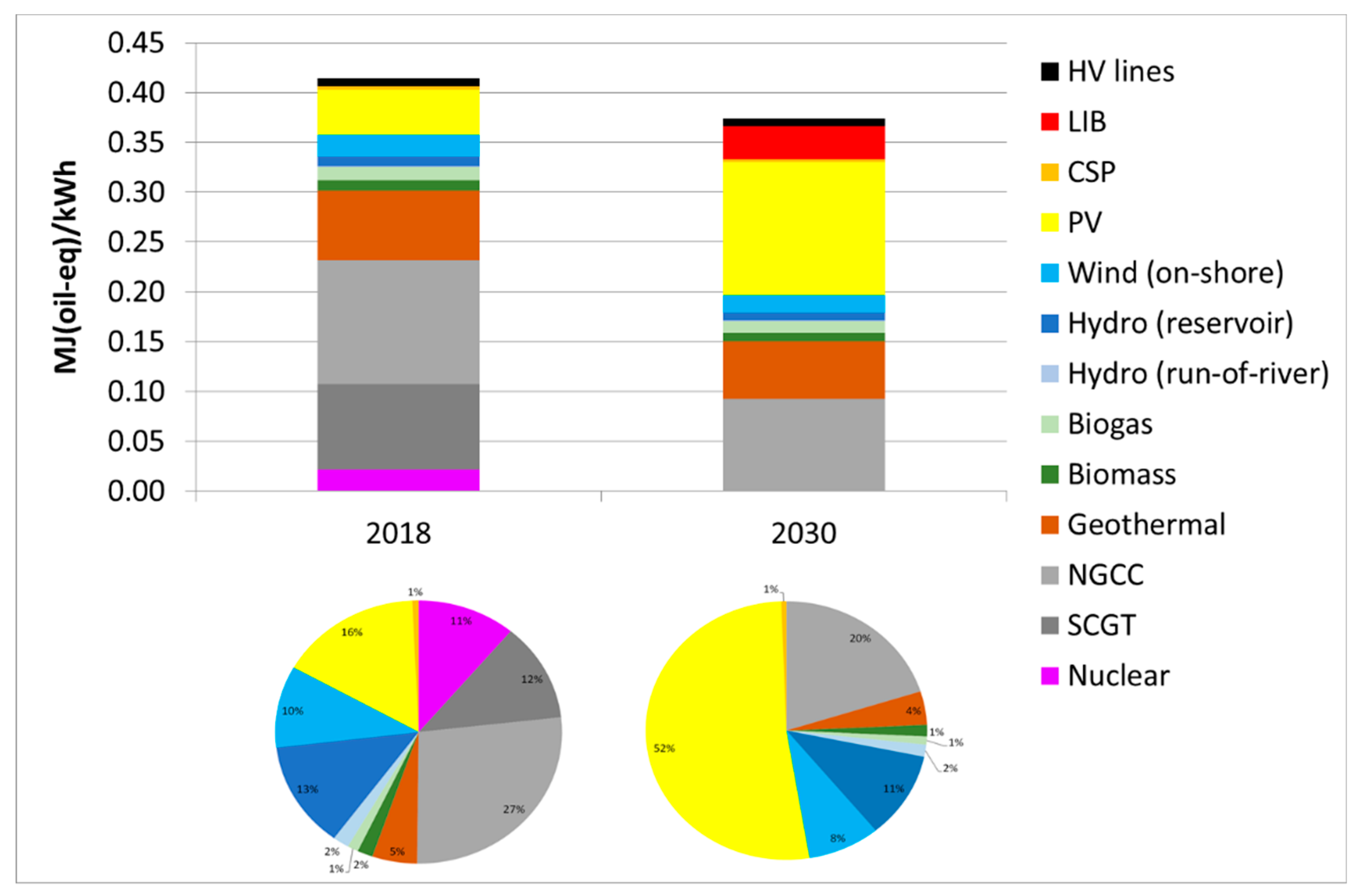
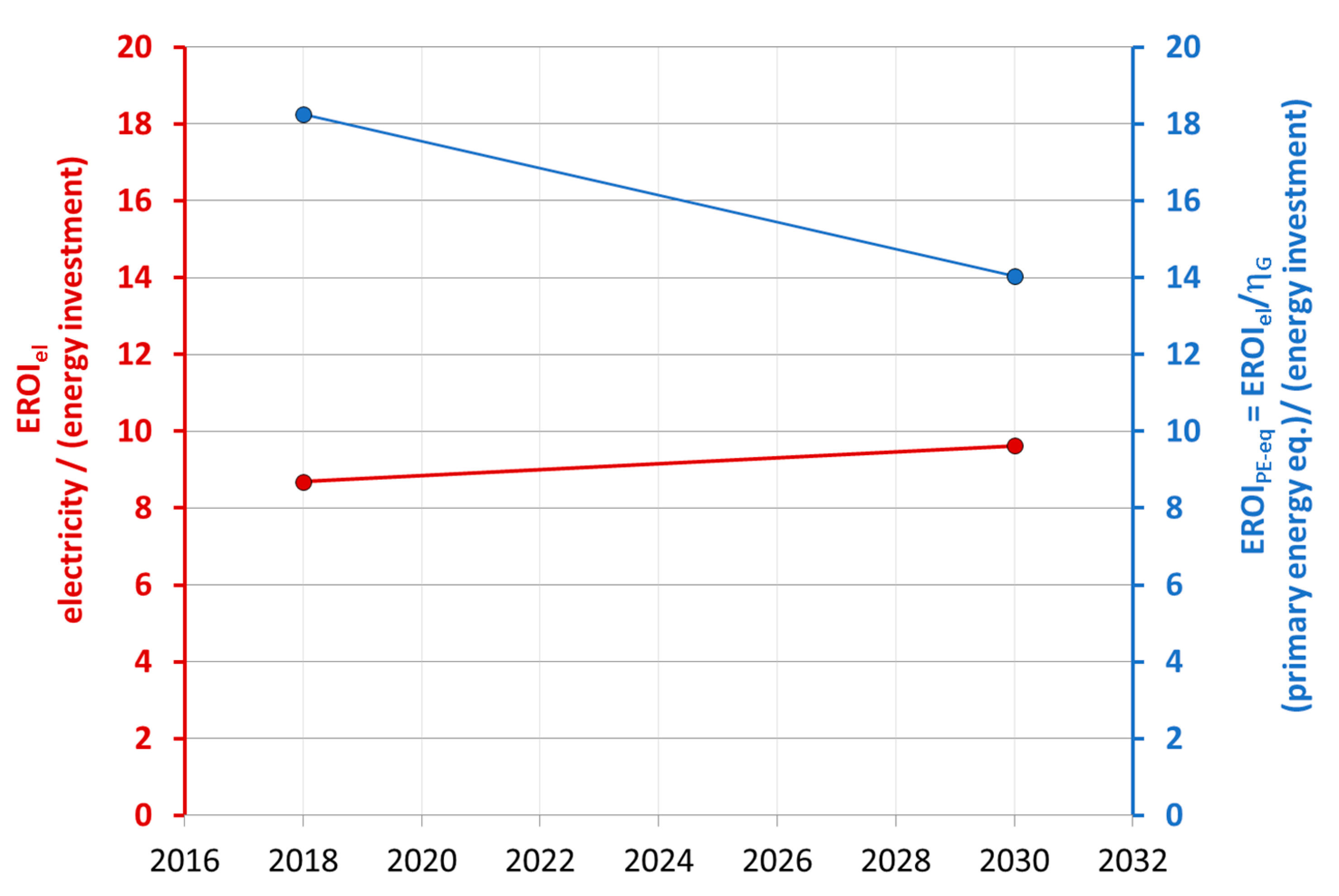
| 2018 Grid [%] | 2018 Grid [TWh/yr] | 2030 Grid [%] | 2030 Grid [TWh/yr] | |
|---|---|---|---|---|
| Share of total California demand supplied by domestic generators 1 | 73% | 165 | 88% | 199 |
| Share of net renewable energy (RE 2) in domestic generation mix | 50% | 82 | 80% | 159 |
| Share of net variable renewable energy (VRE 3) in domestic generation mix | 27% | 44 | 61% | 121 |
| Share of net PV generation in domestic generation mix | 16% | 27 | 52% | 104 |
| Share of gross VRE generation that is routed into storage | 0% | 0 | 25% | 32 |
| Share of gross VRE generation that is curtailed | 1% | 0.4 | 2.8% | 3.6 |
| Technology | 2018 EROIel | 2018 EROIPE-eq (ηG = 0.48) | 2030 EROIel | 2030 EROIPE-eq (ηG = 0.69) |
|---|---|---|---|---|
| Nuclear (pressure water reactor) | 20 | 42 | N/A | N/A |
| Natural gas (single-cycle gas turbines) | 5 | 11 | N/A | N/A |
| Natural gas (combined cycles) | 8 | 17 | 8 | 12 |
| Geothermal (a) | 3 | 6 | 3 | 4 |
| Biomass (co-generation) (a) | 6 | 14 | 6 | 9 |
| Biogas (co-generation) (a) | 4 | 7 | 4 | 5 |
| Hydro (run-of-river) | 70 | 148 | 70 | 102 |
| Hydro (reservoir) | 53 | 112 | 53 | 78 |
| Wind (on-shore) | 18 | 37 | 18 | 25 |
| Photovoltaic | 13 | 28 | 15 (b) | 22 (b) |
| Concentrating solar power | 8 | 18 | 8 | 12 |
| Grid Mix Results | 2030 (“Conservative” PV Assumptions) (a) | 2030 (“Optimistic” PV Assumptions) (b) |
|---|---|---|
| GWP [kg(CO2-eq)/kWh] | 0.109 | 0.105 |
| CED [MJ(oil-eq)/kWh] | 5.26 | 5.16 |
| nr-CED [MJ(oil-eq)/kWh] | 1.77 | 1.72 |
| EROIel [MJ(el)/MJ(oil-eq)] | 9.6 | 11 |
© 2020 by the authors. Licensee MDPI, Basel, Switzerland. This article is an open access article distributed under the terms and conditions of the Creative Commons Attribution (CC BY) license (http://creativecommons.org/licenses/by/4.0/).
Share and Cite
Raugei, M.; Peluso, A.; Leccisi, E.; Fthenakis, V. Life-Cycle Carbon Emissions and Energy Return on Investment for 80% Domestic Renewable Electricity with Battery Storage in California (U.S.A.). Energies 2020, 13, 3934. https://doi.org/10.3390/en13153934
Raugei M, Peluso A, Leccisi E, Fthenakis V. Life-Cycle Carbon Emissions and Energy Return on Investment for 80% Domestic Renewable Electricity with Battery Storage in California (U.S.A.). Energies. 2020; 13(15):3934. https://doi.org/10.3390/en13153934
Chicago/Turabian StyleRaugei, Marco, Alessio Peluso, Enrica Leccisi, and Vasilis Fthenakis. 2020. "Life-Cycle Carbon Emissions and Energy Return on Investment for 80% Domestic Renewable Electricity with Battery Storage in California (U.S.A.)" Energies 13, no. 15: 3934. https://doi.org/10.3390/en13153934
APA StyleRaugei, M., Peluso, A., Leccisi, E., & Fthenakis, V. (2020). Life-Cycle Carbon Emissions and Energy Return on Investment for 80% Domestic Renewable Electricity with Battery Storage in California (U.S.A.). Energies, 13(15), 3934. https://doi.org/10.3390/en13153934








